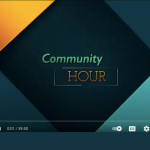
Hello again, dear friends and readers!
I don’t know if the following words resonate with you or not, but somehow, when the month of April is with us, the saying I most remember is a hopeful one; this is “April showers bring May flowers!”
Hope is our guiding star…
For those of you a bit unsure about what this means, I think the most well-known understanding around this poetic adage is that after the heavy showers of April, as the month of May approaches, it is time for beautiful flowers to bloom once again, and the carpet of green to finally replace the dirty snow piles on sidewalks.
Going beyond the weather though-so different in every part of the world, so that April may or may not bring those proverbial showers-this simply means that although there will always be times of challenge and adversity in everyone’s lives, all times are transient, and we must know that good times are on their way just as the light of day naturally follows the darkness each night brings.
Hope is- or should be-everyone’s guiding star to follow, wouldn’t you say, as, without hope, there is no future and nothing to look ahead to; and what is life if joy and anticipation of better times goes missing from it?
So, my first thought today is a hopeful one, urging us all to stay alert to the promise of warm weather; soon the first tulips will begin to raise their sleepy heads….
April is also a time of year that signifies revival and renewal, rebirth and the start of something new, with festivities around the world for those practicing a variety of faiths-for instance, those celebrating Eid, and Passover, Easter and Baisakhi.
In the case of the Indian subcontinent, I’m aware that in some shape or form, most peoples and cultures celebrate this harvest time as a proxy new year.
And then there’s Earth Day- which passed on April 22 this year- staking its claim too- this day demands of us all that we pledge our allegiance to the natural world, and that we stand up for environmental protection, doing our part to preserve the planet.
In the not-for-profit sector too, April is a time when old projects have wrapped up and new ones have begun-a time and an opportunity to start again; or even to reiterate our commitments to continue on but with fresh energy and new momentum.
For us at CMCCF, we too want to bring further clarity around our goals and objectives in the upcoming (financial) year, so we may move forward with renewed focus.
The J.E.D.I Initiative: Plans and Goals for Outcomes in the Second Year
In 2023-2024, our team at CMCCF continues the work on the J.E.D.I Initiative that we started last year, with the objective of strengthening the capacities for self-determination and for leadership- in the case of cultural communities in Manitoba, both in Winnipeg, and in rural communities outside the city.
Further expanding and consolidating this work and our goals- through conducting learning events and speaker panels, training sessions and storytelling circles (including a storytelling festival, planned for this year), we will be exploring the potential of new strategies that can help us further zoom in to finesse the plans we aim to implement this year.
Supporting youth and women cohorts in cultural communities through training in engaging intergenerational groups through dialogue, helping them in building their leadership skills, is one of the important areas of emphasis this year.
Employing approaches that use a ‘collective impact approach’ in all the activities we plan and implement is another important aspect of the foundational framework we will utilize. (See the CMCCF website for more details on this approach).
Ultimately, the hoped-for outcomes we wish to achieve through these activities is for cultural communities to engage more actively and confidently with systems, be it in accessing services or in problem-solving when they experience challenges; it is also about becoming more comfortable speaking out and self-advocating (or advocating for their peers) through identifying gaps only we/ they know exist, and expressing in a strong voice what their unmet needs and aspirations are.
Actualizing Principles and Policies of Equity, Diversity and Inclusion in Lived Experience
The goals of the Coalition are a part of our vision to realize how the future of diverse cultural communities in Canada can be one where:
(a) principles of equity, inclusion, and human rights that already exist in policy frameworks are actualised in the lived experience of individuals and groups, and;
(b) the assets that newcomer, immigrant, and refugee groups come to Canada with are expanded so they may play a more active role in identifying (and creating) meaningful pathways for their careers, their overall growth and their sense of belonging.
When members of cultural communities feel integrated in their environment, feeling empowered to take initiative to lead themselves and their communities to a future which is not discriminatory, and it is inclusive, is also when they will feel better enabled to prioritize their own well-being.
All these objectives will be easier to achieve if individuals do not stay in their separate ethnic silos, but reach out across the aisles, seeking allyship beyond their own cultural or ethnic communities; this will help in building solidarities with members of other racialized and ethnic groups, including with indigenous peoples, and with other mainstream populations.
Reflecting briefly on the role a social justice-based approach can play in actualizing values of equity, diversity, and inclusion in the real-life experiences of individuals, I will offer a few observations below.
The key question to consider here may be: how can a social justice-oriented way of thinking be used to create frameworks to build practices, processes, and policies where diversity is truly valued as a positive attribute; conditions are created where equal opportunities exist for all individuals to live, work, and play; and where all aspects of the environment are conducive to ensuring that our identities- the `who we are’- is validated, so that each individual’s ability to belong, thrive and flourish is expanded.
'Equity is like being invited to a party, and Inclusion is about being asked to dance:’
Do you agree?
In one of the webinars that I attended on zoom during our early pandemic times, for the first time I heard the difference between equity and inclusion being described as `equity is like being invited to a party, and inclusion is about being asked to dance.’
It sounded like a very interesting way to explain the difference, I must say, but it also intrigued me, forcing me to think deeper, and even question this kind of description of the difference between the two terms-equity and inclusion. I began to wonder: if I’m invited to the party, surely that’s my opportunity, and right too, to enjoy all that’s there on offer- the food, conversations with other guests, activities (including dancing if I so choose). Must I then wait to be specially invited to participate in the dance?
Yes, maybe, if I’m standing on the side, waiting to be asked, it would be a nice gesture on the part of someone who’s trying to include me, making the effort to ensure I feel welcome.
My bigger point though, is that I don’t necessarily need to be invited for the dance as I’m already here, so I could also ask what’s preventing me from stepping on to the dance floor?
It could be our own sense of belonging that is missing when we don’t feel comfortable participating; and this could be due to a loss of confidence triggered by being in an unfamiliar space-like in a new city or country where we don’t yet have friends we trust.
Maybe we’re hesitant as we’re uncertain about how things are done here; or we suddenly don’t even know who we are, as our sense of self is feeling destabilized.
And it is this diffidence-and the sense of inadequacy it might lead to-that becomes the internal barrier preventing us from taking up the space to dance (or participate fully, like we may want to). It may also be that we have experienced racist behaviors or microaggressions in this new environment in the past, and now we’re trying to be doubly careful, overcompensating by building walls around us to prevent ourselves from being hurt or insulted.
Long story short, many factors may be intermeshed when we get into talking about ‘experiencing’ what equity, inclusion and diversity can `feel’ like for individuals.
Policy works with a one-size-fits-all approach (and that’s one of the problems with it too) but not individuals; we are all unique beings, carrying our own baggage of lived experience, emotion and personality traits, and so meaning-making must come from a truly subjective place.
Yes, our understanding must be nuanced, as life is complicated, painted in many shades of gray, to say the least!
So, stay with me while we continue to peel the layers of this onion every month, and while doing so, I promise we will keep raising more questions as we go forward on our J.E.D.I. journey together. More next time…

The views expressed in this blog post are mine, and I take full responsibility for them. We are always wanting to hear from you – please share your thoughts and feedback by completing our contact form here or by emailing hello@cmccfamilies.ca.
To learn more about our Intercultural and Intergenerational Diversity and Inclusion Engagement Project, go to our J.E.D.I. Initiative landing page here.

 Previous Post
Previous Post Next Post
Next Post